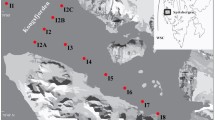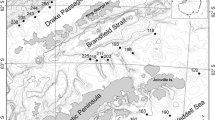Abstract
Organic carbon occluded in diatom silica is assumed to be protected from degradation in the sediment. δ13C from diatom carbon (δ13C(diatom)) therefore potentially provides a signal of conditions during diatom growth. However, there have been few studies based on δ13C(diatom). Numerous variables can influence δ13C of organic matter in the marine environment (e.g., salinity, light, nutrient and CO2 availability). Here we compare δ13C(diatom) and δ13C(TOC) from three sediment records from individual marine inlets (Rauer Group, East Antarctica) to (i) investigate deviations between δ13C(diatom) and δ13C(TOC), to (ii) identify biological and environmental controls on δ13C(diatom) and δ13C(TOC), and to (iii) discuss δ13C(diatom) as a proxy for environmental and climate reconstructions. The records show individual δ13C(diatom) and δ13C(TOC) characteristics, which indicates that δ13C is not primarily controlled by regional climate or atmospheric CO2 concentration. Since the inlets vary in water depths offsets in δ13C are probably related to differences in water column stratification and mixing, which influences redistribution of nutrients and carbon within each inlet. In our dataset changes in δ13C(diatom) and δ13C(TOC) could not unequivocally be ascribed to changes in diatom species composition, either because the variation in δ13C(diatom) between the observed species is too small or because other environmental controls are more dominant. Records from the Southern Ocean show depleted δ13C(diatom) values (1–4 ‰) during glacial times compared to the Holocene. Although climate variability throughout the Holocene is low compared to glacial/interglacial variability, we find variability in δ13C(diatom), which is in the same order of magnitude. δ13C of organic matter produced in the costal marine environment seems to be much more sensitive to environmental changes than open ocean sites and δ13C is of strongly local nature.
Similar content being viewed by others
References
Mackie E, Lloyd JM, Leng MJ, Bentley MJ, Arrowsmith C (2007) Assessment of δ13C and C/N ratios of bulk organic matter as paleosalinity indicators in Holocene and late glacial isolation basin sediments, northwest Scotland. J Quat Sci 22:579–591
Wagner T, Herrle J, Sinninghe Damste J, Schouten S, Stüsser I, Hofmann P (2008) Rapid warming and salinity changes Cretaceous surface waters in the North Atlantic. Geology 36:203–206
Degens ET, Guillard RR, Sackett WM, Helleburst JA (1968) Metabolic fractionation of carbon isotopes in marine plankton: temperature and respiration experiments. Deep-Sea Res 15:1–9
Popp B, Laws E, Bidigare RR, Dore JE, Hanson K, Wakeham SG (1998) Effect on phytoplankton cell geometry on carbon isotopic fractionation. Geochim Cosmochim Acta 62:69–77
Gibson JAE, Trull T, Nichols PD, Summons RE, McMinn A (1999) Sedimentation of 13C-rich organic matter from Antarctic sea-ice algae: a potential indicator of past sea-ice extent. Geology 27:331–334
Laws EA, Popp BN, Cassar N, Tanimoto J (2002) 13C discrimination pattern in oceanic phytoplankton: likely influence of CO2 concentrating mechanisms, and implications for paleoreconstructions. Funct Plant Biol 29:323–333
Lourey M, Trull TW, Tilbrook B (2004) Sensitivity of Southern Ocean suspended and sinking organic matter to temperature, nutrient utilisation, and atmospheric CO2. Deep-Sea Res I 51:281–305
Rau GH, Froehlich PN, Takahashi T, Des Marais DJ (1991) Does sedimentary organic δ13C record variations in Quaternary ocean (CO2(aq))? Paleoceanography 6:335–347
Rau GH, Chavez FP, Friedrich GE (2001) Plankton 13C/12C variations in Monterey Bay, California: evidence of non-diffusive inorganic carbon uptake by phytoplankton in an upwelling environment. Deep-Sea Res I 48:79–94
Fischer G (1991) Stable carbon isotope ratios of plankton carbon and sinking organic matter from the Atlantic sector of the Southern Ocean. Mar Chem 35:581–596
Maslin MA, Swann GEA (2006) Isotopes in marine sediments. In: Leng MJ (ed) Isotopes in paleoenvironmental research. Springer, The Netherlands
Pike J, Allen C, Leventer A, Stickley C, Pudsey C (2008) Comparison of contemporary and fossil diatom assemblages from the western Antarctic Peninsula shelf. Mar Micropaleontol 67:274–287
Sigman DM, Altbet MA, Francois R, McCorkle DC, Gaillard J-F (1999) The isotopic composition of diatom-bound nitrogen in Southern Ocean sediments. Paleoceanography 14:118–134
Abramson L, Wirick S, Lee C, Jacobson C, Brandes JA (2009) The use of soft X-ray spectromicroscopy to investigate the distribution and composition of organic matter in a diatom frustule and a biomimetric analogue. Deep-Sea Res II 56:1369–1380
White DA, Bennike O, Berg S, Harley SL, Fink D, Kiernan K, McConnell A, Wagner B (2009) Geomorphology and glacial history of Rauer Group, East Antarctica. Quat Res 72:80–90
Berg S, Wagner B, Cremer H, Leng MJ, Melles M (2010) Late Quaternary environmental and climate history of Rauer Group, East Antarctica. Palaeogeogr Palaeoclimatol Palaeoecol 297:201–213
McMinn A, Gibson J, Hodgson D, Aschman J (1995) Nutrient limitation in Ellis Fjord, eastern Antarctica. Polar Biol 15:269–276
McMinn A, Bleakley N, Steinburner K, Roberts D, Trenerry L (2000) Effect of permanent sea ice cover and different nutrient regimes on the phytoplankton succession of the fjords of the Vestfold Hills Oasis, eastern Antarctica. J Plankton Res 22:287–303
Stickley CE, Pike J, Leventer A, Dunbar R, Domack EW, Brachfeld S, Manley P, McClennen C (2005) Deglacial ocean and climate seasonality in laminated diatom sediments, Mac. Robertson Shelf, Antarctica. Palaeogeogr Palaeoclimatol Palaeoecol 227:290–310
Annett AM, Carson DS, Crosta X, Clarke A, Ganeshram RS (2009) Seasonal progression of diatom assemblage in surface waters of Ryder Bay, Antarctica. Polar Biol 33:13–29
Cartwright I, Buick IS, Harley SL (1997) Timing and mechanisms of carbon isotope exchange in granulite-facies calc-silicate boudins, Rauer Group, East Antarctica. Am Mineral 82:392–404
Morley DW, Leng MJ, Mackay AW, Sloane HJ, Rioual P, Batterbee RW (2004) Cleaning of lake sediment samples for diatom oxygen isotope analysis. J Paleolimnol 31:391–401
DeMaster DJ (1981) The supply and accumulation of silica in the marine environment. Geochim Cosmochim Acta 45:1715–1732
Battarbee RW (1973) A new method for estimation of absolute microfossil numbers, with reference especially to diatoms. Limnol Oceanogr 18:647–653
Cremer H, Roberts D, McMinn A, Gore D, Melles M (2003) The Holocene diatom flora of marine bays in the Windmill Islands, East Antarctica. Bot Mar 46:82–106
Stuiver M, Reimer PJ, Reimer RW (2005) CALIB 5.0 (www program and documentation)
Hughen KA, Baillie MGL, Bard E, Bayliss A, Beck JW, Bertrand C, Blackwell PG, Buck CE, Burr G, Cutler KB, Damon PE, Edwards RL, Fairbanks RG, Friedrich M, Guilderson TP, Kromer B, McCormack FG, Manning S, Bronk Ramsey C, Reimer PJ, Reimer RW, Remmele S, Southon JR, Stuiver M, Talamo S, Taylor FW, van der Plicht J, Weyhenmeyer CE (2004) Marine04 marine radiocarbon age calibration, 0–26 cal kyr BP. Radiocarbon 46:1059–1086
Stuiver M, Braziunas TF (1993) Modelling atmospheric 14C influences and 14C ages of marine samples to 10 000 BC. Radiocarbon 35:137–189
Berg S, Wagner B, White D, Melles M (2010) No significant ice sheet expansion beyond present ice margins during the past 4500 yr at Rauer Group, East Antarctica. Quat Res 74:23–25
Berg S, Wagner B, White DA, Cremer H, Bennike O, Melles M (2009) New marine core record of Late Pleistocene glaciation history, Rauer Group, East Antarctica. Antarct Sci 21:299–300
Sicko-Goad LM, Schelske CL, Stoermer EF (1984) Estimation of intracellular carbon and silica content of diatoms from natural assemblages using morphometric techniques. Limnol Oceanogr 29:1170–1178
Hoagland KD, Rosowski JR, Gretz MR, Roemer SC (1993) Diatom extracellular polymeric substances: function, fine structure, chemistry and physiology. J Phycol 29:537–566
Crosta X, Shemesh A, Salvignac ME, Gildor H, Yam R (2002) Late Quaternary variations of elemental ratios (C/Si and Si/Si) in diatom-bound organic matter from the Southern Ocean. Deep-Sea Res II 49:1939–1952
Hayes JM (2001) Fractionation of carbon and hydrogen isotopes in biosynthetic processes. In: Valley JW, Cole DR (eds) Reviews in mineralogy and geochemistry. Mineralogical Society of America, Chantilly, VA
Kröger N, Deutzmann R, Sumper M (1999) Polycationic peptides from diatom biosilica that direct silica nanosphere formation. Science 286:1129–1132
Popp BN, Trull T, Kenig F, Wakeham SG, Rust T, Tilbrook B, Griffiths FB, Wright SW, Marchant HJ, Bidigare RR, Laws E (1999) Controls on the carbon isotopic composition of Southern Ocean phytoplankton. Global Biogeochem Cycles 13:827–843
Hodgson DA, McMinn A, Kirkup H, Cremer H, Gore D, Melles M, Roberts D, Monitel P (2003) Colonization, succession, and extinction of marine floras during a glacial cycle: a case study from the Windmill Islands (east Antarctica) using biomarkers. Paleoceanography 18. doi:10.1029/2002PA000775
McMinn A, Skerratt J, Trull T, Ashworth C (1999) Nutrient stress gradient in the bottom 5 cm of fast ice, McMurdo Sound, Antarctica. Polar Biol 21:220–227
Munro D, Dunbar R, Mucciarone DA, Arrigo KR, Long MC (2010) Stable isotope composition of dissolved inorganic carbon and particulate organic carbon in sea ice from Ross Sea, Antarctica. J Geophys Res. doi:10.1029/2009JC005661
Leventer A, Domack EW, Ishman SE, Brachfeld S, McClennen CE, Manley P (1996) Productivity cycles of 200–300 years in the Antarctic Peninsula region: understanding linkages among the sun, atmosphere, oceans, sea ice, and biota. GSA Bull 108:1626–1644
Gersonde R, Crosta X, Abelmann A, Armand L (2005) Sea-surface temperature and sea ice distribution of the Southern Ocean at the EPILOG Last Glacial Maximum—a circum-Antarctic view based on siliceous microfossil records. Quat Sci Rev 24:869–896
Cremer H, Gore D, Melles M, Roberts D (2003) Palaeoclimatic significance of late Quaternary diatom assemblages from southern Windmill Islands, East Antarctica. Palaeogeogr Palaeoclimatol Palaeoecol 195:261–280
McMinn A (2000) Late Holocene increase in sea ice extent in fjords of the Vestfold Hills, eastern Antarctica. Antarct Sci 12:80–88
Jacot Des Combes H, Esper O, De La Rocha CL, Abelmann A, Gersonde R, Yam R, Shemesh A (2008) Diatom δ13C, δ15N and C/N since the Last Glacial Maximum in the Southern Ocean: potential impact on species composition. Paleoceanography. doi:10.1029/2008PA001589
Wagner B, Bennike O, Berg S, Fritz M, Klatt O, Klug M, Muhle K, Ortlepp S, Vogel H, White DA, Melles M (2008) Late Quaternary environmental history of the Rauer Group, as deduced from lake and marine basin sediments. In: Hubberten H (ed) Reports on Polar and Marine Research 583:80–94
Weiss R (1974) Carbon dioxide in water and seawater: the solubility of a non-ideal gas. Mar Chem 2:203–215
Zielinski U, Gersonde R (1997) Diatom distribution in the Southern Ocean surface sediments (Atlantic sector): implications for paleoenvironmental reconstructions. Palaeogeogr Palaeoclimatol Palaeoecol 129:213–250
Crosta X, Shemesh A (2002) Reconciling down core anticorrelation of diatom carbon and nitrogen isotopic ratios from the Southern Ocean. Paleoceanography 17(1):1010
McMinn A, Hodgson D (1993) Summer phytoplankton succession in Ellis Fjord, eastern Antarctica. J Plankton Res 15:925–938
Denis D, Crosta X, Barbara L, Massé G, Renssen H, Ther O, Giraudeau J (2010) Sea ice and wind variability duting the Holocene in East Antarctica: insight on middle-high latitude coupling. Quat Sci Rev 29:3709–3719
Hernandez-Sanchez M, Venables HJ, Mills RA, Wolff G, Fisher EH, Holtvoeth J, Leng M, Pancost RD (2010) Productivity variation around the Crozet Plateau: a naturally iron fertilised area of the Southern Ocean. Org Geochem 41:767–778
Gallagher JB, Burton HR, Calf GE (1989) Meromixis in an Antarctic fjord: a precursor to meromictic lakes on an isostatically rising coastline. Hydrobiologia 172:235–254
Crosta X, Crespin J, Billy I, Ther O (2005) Major factors controlling Holocene d13Corg changes in seasonal sea-ice environment, Adélie Land, East Antarctica. Glob Biochem Cycles 19:GB4029
Rosenthal Y, Dahan M, Shemesh A (2000) Southern Ocean contributions to glacial-interglacial changes of atmospheric pCO2: an assessment of carbon isotope records in diatoms. Paleoceanography 15:65–75
Schneider-Mor A, Yam R, Bianchi C, Kunz-Pirrung M, Gersonde R, Shemesh A (2005) Diatom stable isotopes, sea ice presence and sea surface temperature records of the past 640 ka in the Atlantic sector of the Southern Ocean. Geophys Res Lett 32:L10704
Author information
Authors and Affiliations
Corresponding author
Rights and permissions
About this article
Cite this article
Berg, S., Leng, M.J., Kendrick, C.P. et al. Bulk Sediment and Diatom Silica Carbon Isotope Composition from Coastal Marine Sediments off East Antarctica. Silicon 5, 19–34 (2013). https://doi.org/10.1007/s12633-012-9113-3
Received:
Accepted:
Published:
Issue Date:
DOI: https://doi.org/10.1007/s12633-012-9113-3




